
The Boeing B-47 Stratojet is a retired American long-range, six-engined, turbojet-powered strategic bomber designed to fly at high subsonic speed and at high altitude to avoid enemy interceptor aircraft. The primary mission of the B-47 was as a nuclear bomber capable of striking targets within the Soviet Union.

The Convair B-36 "Peacemaker" is a strategic bomber that was built by Convair and operated by the United States Air Force (USAF) from 1949 to 1959. The B-36 is the largest mass-produced piston-engined aircraft ever built. It had the longest wingspan of any combat aircraft ever built, at 230 ft (70 m). The B-36 was the first bomber capable of delivering any of the nuclear weapons in the U.S. arsenal from an internal bomb bay without aircraft modifications. With a range of 10,000 mi (16,000 km) and a maximum payload of 87,200 lb (39,600 kg), the B-36 was capable of intercontinental flight without refuelling.

The Tybee Island mid-air collision was an incident on February 5, 1958, in which the United States Air Force lost a 7,600-pound (3,400 kg) Mark 15 nuclear bomb in the waters off Tybee Island near Savannah, Georgia, United States. During a night practice exercise, an F-86 fighter plane collided with the B-47 bomber carrying the large weapon.
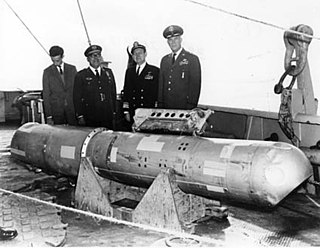
The 1966 Palomares B-52 crash, also called the Palomares incident, occurred on 17 January 1966, when a B-52G bomber of the United States Air Force's Strategic Air Command collided with a KC-135 tanker during mid-air refueling at 31,000 feet (9,450 m) over the Mediterranean Sea, off the coast of Spain. The KC-135 was destroyed when its fuel load ignited, killing all four crew members. The B-52G broke apart, killing three of the seven crew members aboard.

The 305th Air Mobility Wing is a United States Air Force strategic airlift and air refueling wing under the operational control of the Air Mobility Command. It generates, mobilizes and deploys C-17 Globemaster III and KC-10 Extender aircraft. The 305th AMW is a tenant unit at mostly the McGuire AFB component of Joint Base McGuire-Dix-Lakehurst in central New Jersey. It also controls one of the Air Force's busiest aerial ports, and the air operations at both McGuire Air Force Base and Naval Support Activity Lakehurst.
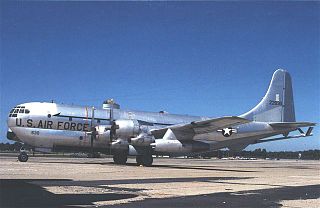
The Boeing KC-97 Stratofreighter is a four-engined, piston-powered United States strategic tanker aircraft based on the Boeing C-97 Stratofreighter. It replaced the KB-29 and was succeeded by the Boeing KC-135 Stratotanker.
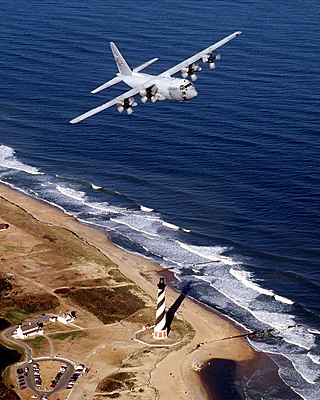
The 43rd Airlift Wing is an inactive United States Air Force unit last stationed at Pope Field, part of Fort Bragg, North Carolina, where it was inactivated in March 2011. The wing performed en route operations support at Pope Field to include mission command & control, aircrew management, aircraft maintenance, aircraft loading, aircraft fueling and supply. Since the wing's inactivation, the 43rd Airlift Group has carried out airlift, maintenance, and base support at Pope Field.
The United States Armed Forces uses a number of terms to define the magnitude and extent of nuclear and radiation accidents and incidents in order to reduce the time taken to report the type of incident, thus streamlining the radio communications in the wake of the event.
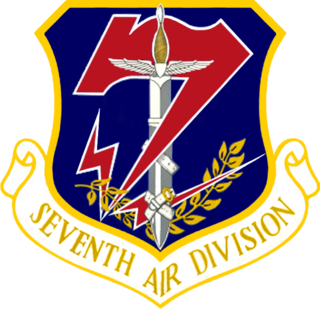
The 7th Air Division served the United States Air Force with distinction from early 1944 through early 1992, earning an outstanding unit decoration and a service streamer along the way.

On 21 January 1968, an aircraft accident, sometimes known as the Thule affair or Thule accident, involving a United States Air Force (USAF) B-52 bomber occurred near Thule Air Base in the Danish territory of Greenland. The aircraft was carrying four B28FI thermonuclear bombs on a Cold War "Chrome Dome" alert mission over Baffin Bay when a cabin fire forced the crew to abandon the aircraft before they could carry out an emergency landing at Thule Air Base. Six crew members ejected safely, but one who did not have an ejection seat was killed while trying to bail out. The bomber crashed onto sea ice in North Star Bay, Greenland, causing the conventional explosives aboard to detonate and the nuclear payload to rupture and disperse, resulting in radioactive contamination of the area.

The 393rd Bomb Squadron is part of the 509th Bomb Wing at Whiteman Air Force Base, Missouri. It operates Northrop Grumman B-2 Spirit nuclear-capable strategic bomber aircraft.

The 823d Air Division is an inactive United States Air Force organization. Its last assignment was with Strategic Air Command (SAC)'s Second Air Force at McCoy Air Force Base, Florida, where it was inactivated on 30 June 1971.

Operation Chrome Dome was a United States Air Force Cold War-era mission from 1960 to 1968 in which B-52 strategic bomber aircraft armed with thermonuclear weapons remained on continuous airborne alert and flew routes to points on the Soviet Union's border.
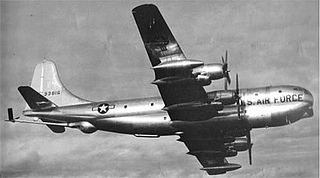
The 26th Air Refueling Squadron was a squadron of the United States Air Force that flew the KC-97E/F/G Stratofreighter, An early Cold War air refueling squadron, it primarily supported B-47 Stratojets of the Strategic Air Command Eighth Air Force during the 1950s and early 1960s. The squadron was inactivated in September 1964 as part of the phaseout of the KC-97 from SAC.
Sidi Slimane Air Base was a military air base in Sidi Slimane, a city in the Rabat-Salé-Kénitra region in Morocco. It is also known as the Fifth Royal Air Force Base, operated by the Royal Moroccan Air Force.

The 4925th Test Group is an inactive United States Air Force unit. Its last was assigned to the 4901st Support Wing (Atomic), stationed at Kirtland Air Force Base, New Mexico. It was inactivated on 31 August 1961. Known as "The Megaton Blasters", the 4925th was responsible for the development flight testing of all USAF nuclear weapon delivery systems including conducting live test drops from 1951 though 1958. The group was discontinued on 1 April 1961, when Air Force Systems Command replaced Air Research and Development Command and components of its mission were distributed among other units.
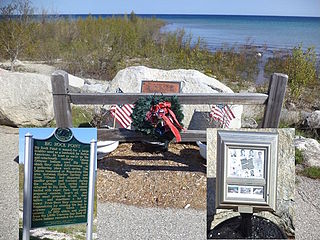
On January 7, 1971, a Boeing B-52C Stratofortress of Strategic Air Command crashed into northern Lake Michigan at the mouth of Little Traverse Bay near Charlevoix, Michigan, while on a low-level training flight. All nine crew members aboard were lost. No remains of the crewmen were recovered. Parts of the aircraft were retrieved from a water depth of 225 feet (69 m) in May and June 1971. The structural remains included parts of the wings, all eight engines, the tail, crew section, landing gear and wheels, plus numerous smaller parts of the plane. Oceans Systems, a Florida-based salvage company, carried out the recovery mission.
















